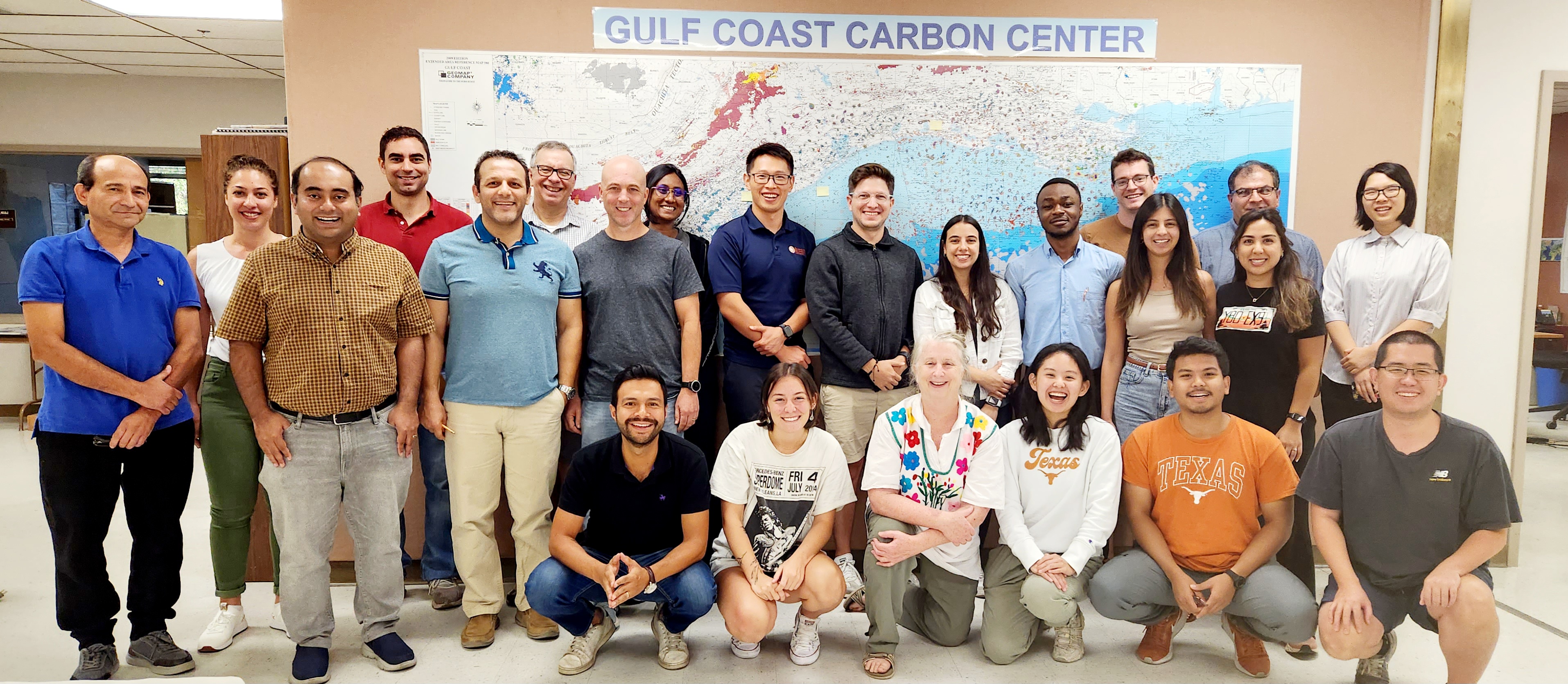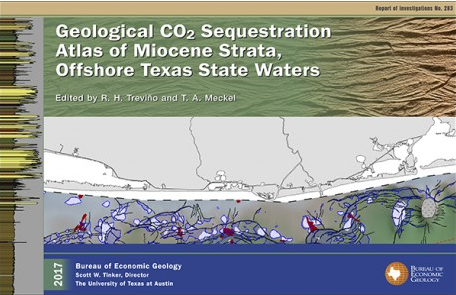Research, Technology, and Education for the Geological Storage of Carbon Dioxide (CO2)
Industrial processes such as the production of cement, iron and steel, and petrochemicals, as well as burning fossil fuels (e.g., gas, oil, and coal) has measurably increased CO2 in Earth’s atmosphere. The long-term consequences of increased concentrations of CO2 gas in Earth’s atmosphere will have negative impacts to oceans and climate.
One possible response is to capture CO2 in industrial settings and reinject it into deep geological reservoirs where it will be retained for long periods of time. This process is called geological sequestration, or carbon capture and storage (CCS).
The Gulf Coast Carbon Center (GCCC) seeks to impact global levels of atmospheric CO2 by
- Conducting studies, often focusing on the Gulf of Mexico, in regard to geological storage, retention and monitoring of CO2 in the deep subsurface
- Educating the public about the process of geological CO2 storage, the risks and mitigation measures associated with carbon capture and storage deployment
- Enabling the private sector to develop an economically viable industry to store CO2 in the Gulf of Mexico, across the U.S., and globally
Since 1998, the GCCC has been a global leader in research that facilitates a proactive response by energy-related businesses to reduce atmospheric release of CO2. The GCCC has led or is in the process of conducting several major field research projects onshore and offshore to develop effective technologies to monitor retention of CO2 in the subsurface. In addition, the GCCC has led a number of diverse projects including estimation of storage capacity, enhanced oil recovery (EOR) screening and economic assessments, risk and monitoring of leakage to water and surface resources, assessment of pressure, and whole-system integration.

The GCCC is a multidisciplinary group that includes experts in geology, hydrology, petroleum engineering, chemistry, economics, and computer modeling. For more information about the researchers, post-docs, and students who comprise the Carbon Center, please see our staff page.
Recent News
April 11–12, 2024: Zhicheng (William) Wang will attend “Breaking the Barrier: A Conference on Integrating Reserves and Emissions” …click to read
April 11, 2024: The GCCC will meet with a visitor from U.S. Department of Energy…click to read
April 11, 2024: Ramón Treviño will attend, and present, at the Texas American Shore and Beach Preservation Association’s 2024 Coastal Symposium …click to read
April 10–12, 2024: GCCC Representatives will attend and present at GEOGULF2024 in San Antonio, TX…click to read
April 10, 2024: Ramón Gil-Egui attended a joint Southern States Energy Board and Center for Carbon Management in Energy (CCME) CCUS Commercialization Acceleration Consortium Meeting at the University of Houston in Houston, Texas…click to read
April 10, 2024: Katherine Romanak and Sue Hovorka were invited to provide remarks on panels for CO2NNECT: CO2 Conversations held in Austin, TX…click to read
April 9, 2024: The GCCC’s Sue Hovorka will attend DAC Dialogues: Bridging Policy and Innovation for Direct Air Capture (DAC) Deployment hosted by the Great Plains Institute and the Carbon Capture Coalition in Austin, TX…click to read
April 5, 2024: Susan Hovorka presented a virtual overview of carbon capture and storage (CCS) to the Texas Farm Bureau…click to read
April 5, 2024: Katherine Romanak provided the GCCC Team with a presentation entitled, “Environmental Baselines: Can’t Live with Them, Can’t Live without Them” for the GCCC’s weekly meeting series…click to read
March 29, 2024: As part of the Bureau of Economic Geology’s Seminar Series, Hailun Ni will present, "Using Sand Tank Experiments to Model CO2 Plume Migration and Trapping."…click to read
March 28, 2024: Alex Bump will present, "Playing for Keeps: Novel Concepts for Carbon Sequestration" at the Bureau of Economic Geology.…click to read
March 27, 2024: Katherine Romanak provided a virtual keynote presentation about Monitoring, Measurement and Verification (MMV) Principles: Principles and Objectives to the Emissions Reduction as part of Alberta’s Carbon Capture and Storage Executive Series…click to read
March 26, 2024: The Bureau of Economic Geology's Gulf Coast Carbon Center (GCCC) had a strong presence for UT’s Energy Week, hosted by the UT Energy Institute.…click to read
March 21, 2024: Sue Hovorka presented “The SECARB early test at Cranfield, what we knew in 2009 and what has changed since then” at the GCCC’s weekly meeting…click to read
March 19–21, 2024: Special thanks to Carlos Uroza for representing the Bureau of Economic Geology’s Gulf Coast Carbon Center by participating in the symposium, entitled the Role of Geosciences in Carbon Storage, which was held in Mumbai, India…click to read
March 15, 2024: Ola Terjeson Miljeteig, VP of CCS Solutions from Equinor in Stavanger, Norway, visited the GCCC and discussed "Equinor's Perspectives on Business, R&D, and Opportunities in CCS" at our weekly meeting …click to read
March 14th, 2024: Excited to announce that the GCCC’s Alex Bump and Sue Hovorka led a workshop associated with and, following the SPE-AAPG-SEG Carbon Capture and Storage (CCUS) Conference…click to read
March 13, 2024: The Gulf Coast Carbon Center’s Texas-Louisiana Carbon Management Community (TXLA CMC), officially emailed the first quarterly newsletter as well as the latest copy of the TXLA CMC phone book out to members…click to read
March 12, 2024: Susan Hovorka and Angela Luciano hosted a film crew from Korea Education Broadcasting System (EBS) in South Korea…click to read
March 11–13, 2024: The GCCC’s research group will have a large impact at the 2024 SPE-AAPG-SEG Carbon Capture and Storage (CCUS) Conference this year…click to read
March 10, 2024: Excited to announce that the GCCC’s Shuvajit Bhattacharya led a workshop associated with and, leading up to the SPE-AAPG-SEG Carbon Capture and Storage (CCUS) Conference…click to read
March 8, 2024: Congratulations to our Master’s Student, Previna Arumugam, for being selected to take part in the prestigious IEAGHG International CCS Summer School…click to read
March 8, 2024: At the GCCC’s weekly meeting, Dolores van der Kolk provided a presentation entitled, Sedimentary Facies & Heterogeneity: Implications for CCS…click to read
March 4, 2024: The GCCC welcomes Dr. Ruichang Guo as a new Postdoctoral Fellow who will be working with Dr. Seyyed Hosseini...click to read
February 26–28, 2024: GCCC Representatives Angela Luciano, Sue Hovorka, and Seyyed Hosseini attended the 2024 Groundwater Protection Council Meeting in Oklahoma City, OK…click to read
February 24, 2024: Special thanks to the GCCC’s Sue Hovorka and Ramón Gil-Egui for volunteering at STEM Girl Day at UT Austin… click to read
February 23, 2024: Zhicheng (William) Wang had a presentation entitled, Numerical Simulation 101 & 201: Introduction to Macro-Scale Simulations, and Pore-Scale Lattice Boltzmann Method (LBM) for our team of researchers and students at our GCCC weekly meeting.
February 22, 2024: Tip Meckel presented the AAPG Distinguished lecture for the University of Oklahoma’s Pigott Colloquium Series…click to read
February 20, 2024: Ramón Treviño presented “Carbon Capture & Sequestration: Implications for Groundwater” to the Texas Commission on Environmental Quality’s (TCEQ’s) bi-monthly brown bag seminar…click to read
February 13–14, 2024: Sue Hovorka, Alex Bump, and Tip Meckel traveled to Reston, Virginia for an in-person only Joint DOE-DOI Technical Workshop on Basin-Scale Issues for Carbon Storage....click to read
February 13, 2024: Texas-Louisiana Carbon Management Community (TXLA CMC) will host the first public kick-off meeting in a webinar…click to read
February 9, 2024: Hailun Ni’s graduate student, Jose Ubillus, presented an update on his research…click to read
February 8, 2024: Excited to announce that Dr. Katherine Romanak virtually presented on the topic of “Carbon Capture - Monitoring, Safety and Geologic Impact of Underground CO2 Injection” to the Healthy Planet Action Coalition…click to read
February 2, 2024: Zhicheng (William) Wang held a virtual EASiTool Workshop for participants currently in the Society of Exploration Geophysicist’s (SEG’s) Evolve Program…click to read
January 30 – February 1, 2024: In Houston, TX, the GCCC’s Carlos Uroza attended the conference entitled, “Investable CCUS Projects in Oil & Gas 2024: Pathways for Commercially Viable Capture, Transportation, Storage, and Utilization for EOR”....click to read
January 30, 2024: Hailun Ni and Sue Hovorka took undergraduate and graduate students from the Jackson School of Geosciences on a field trip at Austin’s Core Research Center…click to read
January 29, 2024: Special thanks to Professor Myles Allen, from the University of Oxford, for visiting us at the Bureau of Economic Geology and Jackson School of Geosciences at The University of Texas at Austin…click to read
January 24–25, 2024: Associated with UTCCS-7 held on January 23, 2024, the Gulf Coast Carbon Center (GCCC) and the Texas Carbon Management Program (TxCMP) hosted a joint meeting for Sponsors of their consortiums…click to read
January 23, 2024: The Gulf Coast Carbon Center (GCCC), joined the Texas Carbon Management Program (TxCMP), and the UT Energy Institute to host UTCCS-7…click to read
January 16, 2024: Lucy Atkinson, Dorothy Dankel, and Katherine Romanak published, “The effect of monitoring complexity on stakeholder acceptance of CO2 geological storage projects in the US gulf coast region” in Frontiers in Marine Science…click to read
January 11, 2024: On behalf of the Bureau of Economic Geology’s Gulf Coast Carbon Center (GCCC), Carlos Uroza was the guest speaker for the Geophysical Society of Houston...click to read
January 11, 2024: Alex Bump's graduate student, Ismail Faruqi, presented at a Sponsors' Meeting for the ongoing, industry-supported, Gulf of Mexico Basin Depositional Synthesis (GBDS) Project…click to read
January 5, 2024: Angela Luciano presented a Tech Talk entitled, “Documenting Long-term Operational Success of Class 1 Wells in the US Gulf Coast to Build Confidence in the UIC Program” at the Bureau of Economic Geology…click to read
January 5, 2024: Carlos Uroza’s graduate student, Maria Madariaga, presented an update at the GCCC’s weekly meeting about her Master’s research…click to read
Click here to view 2024 news and events.
En español: la información de almacenamiento geológico de carbono
The University of Texas at Austin is proud to be associated with BP’s sponsorship of the GCCC, an activity accredited by BP’s Advancing Low Carbon program.


